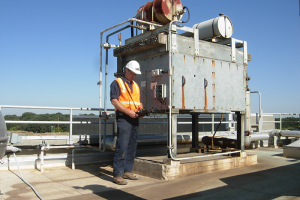Hospitals reduce their carbon footprints with sustainable solutions

Heating and cooling at Advocate Sherman Hospital, Elgin, Ill., uses a hybrid geothermal heat pump system that allows the site to use half the fossil fuels of its peer hospitals.
Image courtesy of Advocate Aurora Health
On the mission of achieving sustainability, hospitals have their sights set on one mammoth target: becoming carbon neutral — achieving net-zero carbon dioxide emissions.
And while the mission is long, challenging and often fraught with obstacles, hospitals have an obligation to embrace sustainability due to the enormity of their carbon footprint and their core commitment to health and healing, according to leaders in the decarbonization movement.
How big is health care’s carbon footprint? To put it in perspective, if the global health care sector were a country, it would be the world’s fifth-largest emitter of greenhouse gases, according to a 2019 report produced by Health Care Without Harm.
The global health care industry is responsible for two gigatons of carbon dioxide each year, or 4.4% of worldwide net emissions — the equivalent of 514 coal-fired power plants.
“The U.S. ranks second among 68 nations in gross emissions, so the need to do something is compelling,” says Gerald A. (Andy) Woommavovah, CHFM, system director of energy and infrastructure at CommonSpirit Health, the largest Catholic health system in the U.S., with more than 1,000 care sites in 21 states.
While the economy, the fight for capital resources and top-down support for green initiatives are constant challenges, the good news is that many hospitals are making real progress through effective, efficient and often cost-effective sustainability measures in three main areas: energy, waste and supply chain.
Having a climate action plan and buy-in from hospital leadership and designated staff who are passionate about saving the environment are critical to success.
And a united front is essential, since success for one hospital leads to success for all, according to Frank Aucremanne, associate vice president of medical center space and facility planning at The Ohio State University Wexner Medical Center in Columbus, Ohio.
“We are all in this together,” Aucremanne says. “When it comes to sustainability, hospitals don’t compete against each other. We share. As one hospital learns something, they can share it with the others.”
Stages of progress
Reaching goals can happen in ways big or small, in the short or long term, and through efforts by internal hospital staff and by aligning with outside organizations like the American Society for Health Care Engineering (ASHE) and Health Care Without Harm.
While they have similar environmental goals, hospitals are at various stages of progress. At one end of the spectrum, Kaiser Permanente, based in Oakland, Calif., became the first health care system to achieve carbon-neutral status in 2020, eliminating its 800,000-ton annual carbon footprint.
Kaiser Permanente achieved its goal through a combination of systemwide energy-efficiency improvements and a focus on renewable energy production, including wind and on- and off-site solar programs across its systems.

Opened in 2013, the Kaiser Permanente Westside Medical Center in Hillsboro, Ore., has 100 kilowatts of solar generation installed on-site and a LEED Gold certification.
Image courtesy of Kaiser Permanente
On the road to becoming carbon neutral, hospitals follow guidelines outlined by the Greenhouse Gas Protocol organization for measuring emissions, which are divided into three scopes:
- Scope 1: Direct from sources owned or controlled by a company.
- Scope 2: Indirect from energy that is purchased.
- Scope 3: All other emissions associated with a company’s activities.
“ASHE’s role really began with tracking utilities and concentrated on scope 1 and 2,” says Kara Brooks, MS, LEED AP BD+C, sustainability program manager at ASHE. “But as we are witnessing a global shift toward decarbonization of buildings, ASHE is working hard to help health care facilities meet their goals. Our effort continues to evolve and grow as we embark on new strategies and resources to help our members.”
Just as critical as having sustainability goals is tracking them, says Lauren Koch, sustainability consultant at The Ohio State Wexner Medical Center.
“You can’t manage what you don’t measure,” Koch says. “Hospitals need to understand their energy use consumption per square foot, benchmark against peers and then understand what initiatives can be implemented to reduce energy.”

The Ohio State University Comprehensive Cancer Center’s Arthur G. James Cancer Hospital and Richard J. Solove Research Institute is a LEED Gold building located on the main Columbus campus.
Image courtesy of The Ohio State University Wexner Medical Center
Most hospitals are setting carbon-neutrality goals for 10 or 20 years down the road and are targeting areas such as energy, waste, supply purchasing, water, food and others. They also often develop smaller, even grassroots, initiatives to drive progress.
Ohio State set a goal to become carbon neutral by 2050, and the medical center is a key part of achieving that goal. Through its energy reduction working group, The Ohio State Wexner Medical Center is cutting energy use across its facilities, including operating rooms (ORs), which, according to Practice Greenhealth, use anywhere from three to six times more energy per square foot than anywhere else in the hospital.
The Ohio State Wexner Medical Center implemented reusable sharps containers to reduce environmental impact. In just two months, the hospital has already avoided 7,000 pounds of plastic. And by collecting blue sterilization wrap at two outpatient surgical sites, The Ohio State Wexner Medical Center diverted more than 2,000 pounds of waste from landfills.
Adopting light-emitting diode (LED) lights and variable-frequency drives allows HVAC equipment to dial back output and save energy when rooms are not in use, says Aucremanne.
“We work closely with clinicians to create a schedule for ramping down operating rooms when they aren’t in use,” he says. “This is all automated to maximize savings, but we have manual overrides to allow clinicians to bring an OR back online in the event of an emergency.”
Facility management plays an important role in the hospitalwide effort to realize the Climate Action Plan at CommonSpirit, which was founded in 2019 by the merger of Dignity Health and Catholic Health Initiatives and is headquartered in Chicago.
“For our facility management program, we have a lot to contribute with scope 1 and 2 emissions,” Woommavovah says. “Remembering that scope 1 is what we consume on-site, we can impact becoming efficient with equipment, controls and the use of renewables.”
As a leader in high-performance building operations, Advocate Aurora Health, one of the top 12 largest nonprofit health systems in the U.S., with a facility fleet of 26 hospitals and over 500 sites of care serving Wisconsin and Illinois, has in the past few years partnered with engineering consulting firms for building system retrocommissioning, says Jedd Winkler, energy program manager for the building fleet.

Advocate Illinois Masonic Medical Center in Chicago, shown with its distinctive shading system in front, recently received its 11th ENERGY STAR certification with a score of 99 and secured renewable energy credits for its electric energy use for 2021.
Image courtesy of Advocate Aurora Health
Facility operations leaders are vigilant in benchmarking energy use and utilizing that data to innovate in implementing energy-savings initiatives with the resources available, Winkler says.
“I don’t think it’s a real secret recipe,” Winkler says. “Optimize the operation of the equipment you have; correct any deficiencies; when replacing equipment, be cognizant that is the time to upgrade the component or system; and influence new building system design to make sure the infrastructure is a platform for efficient operation.”
Since opening two years ago, CommonSpirit has already created a systemwide reporting initiative to track the energy performance at all directly owned acute care locations. “As a result of that reporting, we have initiated a systemwide retrocommissioning program with first focus on high energy use intensity locations,” Woommavovah says.
Leading the way
A decades-long leader in sustainability, Renton, Wash.-based Providence Health & Services, a nonprofit Catholic health care system operating across seven states, set an ambitious goal to become carbon negative — removing more carbon from the atmosphere than it generates — by 2030.
Providence’s multifaceted action plans focus on everything from how design and construction will impact the facility environment to maintaining the dramatic drop in business travel achieved during the COVID-19 pandemic. The health system includes 51 hospitals and more than 800 nonacute care facilities.
“COVID-19 certainly put a spotlight on energy in a big way,” says Geoff Glass, director of facility and technology services and energy sustainability manager at Providence St. Peter Hospital, Olympia, Wash. “Along with reducing business travel, we are encouraging more remote work, creating facilities with more shared spaces and reconfiguring offices with energy efficiency in mind.”
And Providence is constantly searching for ways to reduce greenhouse gases. The hospital has led the way in targeting a major source of emissions: inhaled anesthetics. Waste anesthetic gases are vented from hospital rooftops and emitted into the atmosphere but are not regulated.
“But there are clinical interventions that can minimize those emissions, since different types of anesthetics are higher in emissions than others,” Glass says.
At Providence, anesthesiologist Brian Chesebro, M.D., investigated the two types of drugs used during anesthesia — desflurane and sevoflurane — and discovered that desflurane is 20 times more powerful in trapping heat in the Earth’s atmosphere than sevoflurane. As a result, Providence hospitals prioritized the use of sevoflurane over desflurane in all eight of its hospitals in Oregon for a savings of about $500,000 per year.
As part of its Greening the Operating Room Program, The Ohio State Wexner Medical Center also targeted gases associated with anesthesia, reducing the use of desflurane across the health system by 46%, achieving nearly $185,000 in cost savings.
Renewable energy
Larger health care systems that are leading the way in sustainability are having real success with on- and off-site renewable energy programs using solar and wind.
At Kaiser Permanente, the largest purchaser of renewable energy in the U.S. health care sector, the first on-site solar project went online in 2011. By 2015, Kaiser Permanente began to ramp up its solar program on a much larger scale after a systemic assessment of its facilities, says Seth Baruch, Kaiser Permanente’s national director for energy and utilities, who oversees 39 hospitals and 724 medical offices in the Kaiser Permanente system.

The Kaiser Permanente Alton/Sand Canyon Medical Offices in Irvine, Calif., has 800 kilowatts of solar generation installed within its parking area.
Image courtesy of Kaiser Permanente
“Kaiser Permanente really wants to deploy solar on a big scale,” Baruch says. “And now about 95 different locations have rolled out solar programs in California, Colorado and Hawaii.”
The first step is determining whether on-site solar will be economically feasible. “If the answer to that question is yes, meaning at or below what we’re currently paying for electricity, it’s easier to get buy-in for the project,” Baruch says.
On-site solar also helps strengthen a hospital’s brand, says Baruch. “People see a solar array at a hospital and recognize right away that the hospital is concerned about the environment.”
Through its off-site renewable energy programs, Kaiser Permanente is able to generate 330 megawatts of wind and solar power, greatly contributing to its carbon-neutral status. In addition, the off-site energy acts as a hedge against the volatility of energy markets, says Baruch.
Kaiser Permanente is also focusing on expanding microgrids. Kaiser Permanente’s Richmond Medical Center was the first hospital in California to implement a microgrid that connects renewable energy and battery storage to a preexisting, diesel-fueled backup power system in a hospital. The project was funded by a grant of nearly $5 million from the California Energy Commission.
“So many hospitals are exposed to wildfire-related power outages that we’re counting on the resiliency of microgrids,” says Baruch, adding that a half dozen or so microgrid projects are in the pipeline.
Kaiser Permanente, which plans to announce its scope 3 reduction targets later this year, is focusing heavily on reducing the carbon emissions within the supply chain, Baruch says.
“We are looking at everything, from construction materials to pharmaceuticals and imaging equipment and down the line,” Baruch says. “Along with microgrids, the supply chain will be our single biggest focus.”
Supply chain procurement
In fact, because nearly 70% of hospital emissions come from the supply chain, many hospitals are focusing on sustainable procurement to reduce carbon emissions.

The Ohio State Havener Eye and Ear Institute, located just off the main medical center campus, was the first site to implement blue wrap recycling in its operating rooms.
Image courtesy of The Ohio State University Wexner Medical Center
The Ohio State Wexner Medical Center set sustainable procurement goals for every product that comes into the hospital — from medical equipment and devices to furniture, flooring, patient gowns and breast pumps.
“We developed sustainable procurement guidelines and look for materials that have specific environmental attributes. Purchasing products with fewer chemicals is a major priority,” Koch says. “Vendors are responding and providing these products often at cost-neutral options.”
Koch says the hospital works with their group purchasing organization (GPO) in following a list of 23 environmentally preferred product attributes such as latex-free, mercury-free, BPA-free and recyclable packaging. That has helped them track progress, and in 2020, 75% of purchases through the GPO had at least one environmental attribute.
Since 2011, The Ohio State Wexner Medical Center has diverted nearly 100 tons of single-use devices from the landfills through a reprocessed medical device program and saved $6.7 million.
Future-focused
While some hospitals have definite advantages in terms of CEO support and funding resources, every hospital can do something, even in terms of lopping off the low-hanging fruit like turning off lights, installing LED exit signs and ramping up recycling programs.
The key, according to hospital leaders, is to get staff involved — even excited — about sustainability through initiatives like Earth Days, creating green teams and designating climate ambassadors to create a culture around sustainability.
“A lot of this is about education,” Aucremanne says. “If employees understand how much energy a hospital consumes and how much waste it generates, then it’s easy to get them motivated and thinking about how they can be part of the solution.”
At CommonSpirit, CEO Lloyd H. Dean serves as co-chair of America Is All In, a national initiative that unites U.S. communities, businesses and institutions to achieve net-zero emissions by 2050. In addition, climate ambassadors are part of the hospital’s mission of environmental stewardship.
“Our climate ambassadors are volunteers throughout the ministry that advocate for climate control initiatives in their hospitals,” Woommavovah says. “They participate in a training session where they learn about how and who is impacted by carbon emissions.”
Perhaps most importantly, hospitals need to remember that sustainability is a constant learning process and sharing information is all-important.
“It is important for leaders to participate in industry forums so that they can hear from others about energy and waste solutions that can be implemented at our own institution,” Aucremanne says. “Likewise, if we have found a successful strategy, it’s important to have a space to share those learnings so that others may benefit as well.”
Adds Koch: “Sustainability in health care is not a zero-sum game. We need all hospitals doing this work across the country — across the world. That’s why it’s important to share our learnings as frequently and widely as possible.”
ASHE takes on growing role in guiding hospital sustainability
As the focus on sustainability in health care has deepened in the past decade, so too has the role of the American Society for Health Care Engineering (ASHE) in guiding hospitals down the path to environmental responsibility.
Introduced in 2010, ASHE’s Energy to Care Program continues to build on a roster of resources for hospitals on every level of sustainability. The energy reduction program offers clear, step-by-step directions for tracking, managing and communicating energy savings.
Energy to Care offers four major products: the Energy to Care Dashboard and benchmarking; Energy to Care educational tools; the Energy to Care Treasure Hunt program; and the Energy to Care awards programs.
Since 2010, hospitals and health care facilities participating in the Energy to Care Program have put over $500 million in energy savings back into patient care.
“ASHE has seen sustainability progress firsthand through the Energy to Care Program and, in particular, the Energy to Care awards program,” says Kara Brooks, MS, LEED AP BD+C, sustainability program manager at ASHE.
Health care facilities receive the Energy to Care Award for saving 10% of their energy use in a single year and 15% over two years. When ASHE began the Energy to Care awards program in 2006, there were nine awardees. In 2020, ASHE named 255 hospitals as award winners, Brooks says.
In ASHE’s Energy to Care Treasure Hunt, based on the federal government’s ENERGY STAR® Treasure Hunts, multidisciplinary teams go on a two-day hunt through a facility, identifying low-cost energy savings opportunities from behavioral, operational and maintenance actions.
“Establishing a culture of sustainability takes commitment by everyone — not just those in the facilities department,” Brooks says.
Brooks also encourages facilities to designate a sustainability champion, someone who has a passion for the environment and the time and commitment necessary to succeed in the role. And hospitals should strive to develop sustainability plans tailored to their specific needs.
“Each facility is different from resource availability to utility usage to culture,” Brooks says. “It is important to tailor the sustainability plans and goals to meet these and other metrics that are consistent with the organization’s mission.”
For more information on ASHE’s Energy to Care Program, visit its website.
Beth Burmahl is a Lisle, Ill.-based freelance writer and former associate editor of Health Facilities Management magazine.





